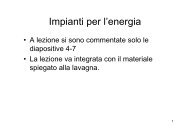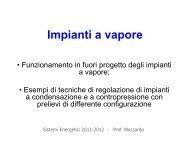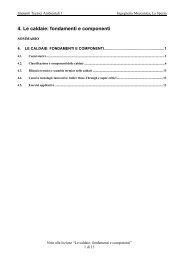Formazione di Inquinanti Legatti alla Combustione nei ... - TPG
Formazione di Inquinanti Legatti alla Combustione nei ... - TPG
Formazione di Inquinanti Legatti alla Combustione nei ... - TPG
You also want an ePaper? Increase the reach of your titles
YUMPU automatically turns print PDFs into web optimized ePapers that Google loves.
Camera <strong>di</strong> <strong>Combustione</strong> per Turbine a Gas, <strong>Formazione</strong> e Tecniche <strong>di</strong> Abbattimento degli <strong>Inquinanti</strong>Unità <strong>di</strong> misura delle emissioniAltri riferimentiNormale metro cubo – Nm 3 : la quantità <strong>di</strong> un certo gas (kmoli o kg) contenuta in un metro cubo dellostesso gas, a p 0 =101325 Pa (pressione atmosferica) e T 0 =0°C (lo standard metro cubo si riferisce invecea 15°C).3R T 0 Nm vmol 22.413p0kmol3 22.4131kmol 22.413Nm ;1kg NmMw3R 8,314510 103Jkmol K Concentrazioni riferite alle unità <strong>di</strong> energia: consente <strong>di</strong> fare almeno del concetto <strong>di</strong> <strong>di</strong>luizionemgMJth mg kgfuel mg 3 NmfuelNel caso <strong>di</strong> una centrale elettrica viene normalmente usato ilMJ el – bisogna conoscere il ren<strong>di</strong>mento dell’impianto.•Le concentrazione riferite all’unità <strong>di</strong> energia sono piùsignificative in rispetto alle precedente.•Misure sperimentali normalmente effettuate inconcentrazioni volumetriche => conoscere: LHV,composizione atomica del combustibile, reazionestechiometrica,...Impianti per l’energia 2010-2011












